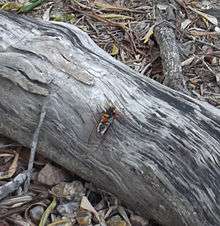Exeirus
| Australian cicada killer wasp | |
|---|---|
 | |
| Exeirus lateritius (Cicada-killer wasp), Fraser Coast, Queensland, Australia | |
| Scientific classification | |
| Kingdom: | Animalia |
| Phylum: | Arthropoda |
| Subphylum: | Hexapoda |
| Class: | Insecta |
| Order: | Hymenoptera |
| Suborder: | Apocrita |
| Infraorder: | Aculeata |
| Superfamily: | Apoidea |
| Family: | Crabronidae |
| Subfamily: | Bembicinae |
| Tribe: | Gorytini |
| Genus: | Exeirus |
| Species: | E. lateritius |
| Binomial name | |
| Exeirus lateritius (Shuckard, 1838) | |
The Australian cicada killer, Exeirus lateritius, the sole member of the genus Exeirus, is a large, solitary, ground-dwelling, predatory wasp. It is related to the more common genus of cicada killers, Sphecius. In Australia, E. lateritius hunts over 200 species of cicada.
Habitat
The wasps occur in warm, dry areas where there are enough trees to support cicadas, such as the Murray-Darling basin, the south-east coast of the Australian mainland, and Tasmania.
Predation method
Exeirus lateritius stings and paralyses cicadas high in the trees, making them drop to the ground, from where the wasp moves them to its burrow, pushing with its hind legs, sometimes over a distance of a hundred meters (300 feet). The paralysed cicada is placed on one of many shelves in a "catacomb", to form the food-stock for the wasp grub which grows out of the egg deposited there.[1]
References
- ↑ Tillyard, P (1926), The Insects of Australia and New Zealand, Sydney: Angus & Robertson, pp. 298–99.